Install and set up DataGrip
Installation requirements
Hardware requirements
- 2 GB RAM minimum, 4 GB RAM recommended
- 500 MB hard disk space + at least 1 GB for caches
- 1024x768 minimum screen resolution
Software requirements
JRE 1.8 is bundled with the DataGrip distribution. You do not need to install Java on your computer to run DataGrip.
| Windows | macOS | Linux |
|---|---|---|
| 32-bit or 64-bit versions of Microsoft Windows 10, 8, 7 (SP1), or Vista (SP2) | macOS 10.8.3 or later (only 64-bit systems are supported) |
|
Download and install DataGrip
- Download DataGrip for your operating system.
- Do the following depending on your operating system:
- Windows installation:
- Run the
*.exefile you've downloaded. - Run the
datagrip-*.exefile you've downloaded. - Follow the instructions in the installation wizard.
- Run the
- macOS installation:
- Open the
.dmgpackage that you've downloaded, and drag DataGrip to the Applications folder. - Open the
datagrip-*.dmgpackage that you've downloaded, and drag DataGrip to the Applications folder.
- Open the
- Linux installation:
- Unpack the
datagrip-*.tar.gzfile to a different folder, if your currentDownloadfolder doesn't support file execution:tar xfz datagrip-*.tar.gz -C <new_archive_folder>The recommended installation location according to the filesystem hierarchy standard (FHS) is
/opt. To install DataGrip into this directory, enter the following command:sudo tar xfz datagrip-*.tar.gz -C /opt/ - Switch to the
binsubdirectory:For example,cd <new archive folder>/DataGrip-*/bincd /opt/DataGrip-*/bin - Run
datagrip.shfrom thebinsubdirectory.
- Unpack the
- Windows installation:
Earlier DataGrip versions are available for download on the Previous DataGrip Releases page.
Run DataGrip for the first time
Import DataGrip settings
When you start DataGrip for the first time, or after you have upgraded it from a previous version, the Complete Installation dialog opens where you can select whether you want to import the IDE settings:
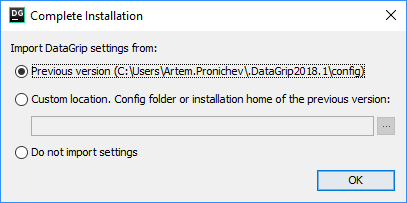
If this is your first instance of DataGrip, choose the Do not import settings option.
Select the user interface theme
Next, you will be prompted to select the UI theme. You can choose between the Default and the Darcula themes:
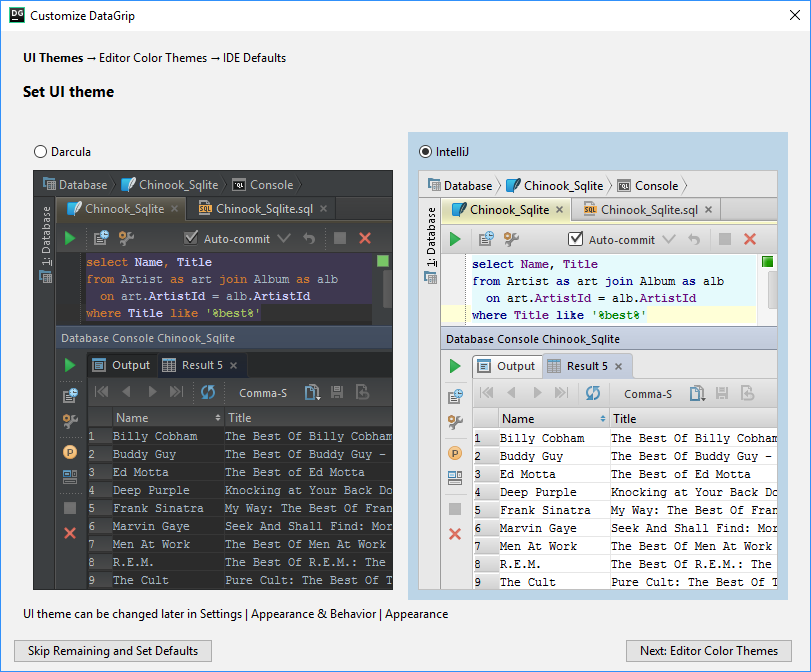
Select a preferred dialect for SQL files
On the next step, you are prompted to select a preferred dialect for SQL files. The selected dialect provides code assistance including syntax analysis, completion, and refactoring. If you plan to use different dialects, select <Generic SQL>.
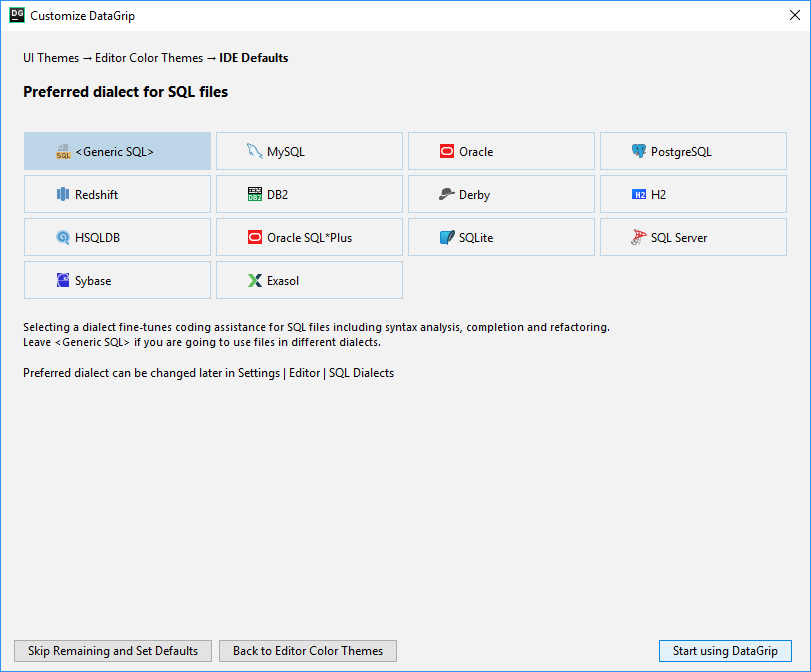
Register DataGrip
To try and evaluate DataGrip, you can download and install its trial version for free. The trial version is available for 30 days, whereupon you need to obtain and register a license.
- Do one of the following:
- On the Welcome screen, click Configure | Manage License
- Select Help | Register from the main menu
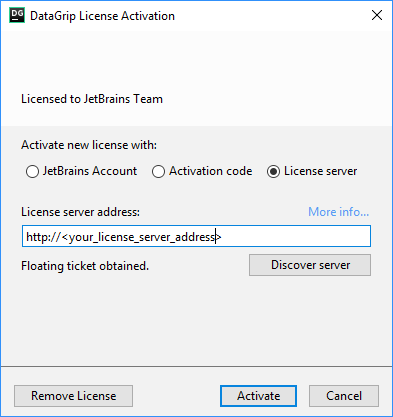
- Select how you want to register DataGrip:
- JetBrains Account: select this option if you have a JetBrains Account that allows you to access your purchases and manage licenses (see What is JetBrains Account? to learn more).
- Activation code: select this option if you have an activation code for DataGrip, and paste it to the text area.
-
License server: select this option to register DataGrip through the License Server web application that allows you to manage floating licenses and issue licenses to users who do not have direct internet access.
To override the URL of the system proxy during initial DataGrip startup, use the
-Djba.http.proxyproperty, which can be added as a JVM option.When performing silent install or managing DataGrip installations on multiple machines, you can set the
JETBRAINS_LICENSE_SERVERenvironment variable to point the installation to the license server URL.
Update DataGrip
- Download the latest version of DataGrip.
- Launch the setup as described in Download and install DataGrip.
- Choose whether you want to uninstall the existing DataGrip version together with its settings, caches and local history and follow the instructions of the installation wizard.
Out of the box, standalone DataGrip installation is configured to check for updates automatically. It will notify you when a new version is available:
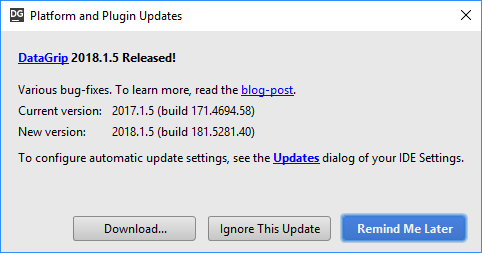
DataGrip updates are usually patch-based: they are applied to the existing installation and only require you to restart the IDE. Note that these patches can only be applied sequentially, on top of one another. If an update is ignored or skipped, subsequent updates cannot be applied. Updating DataGrip in this case will require either downloading and reinstalling it or using the Ignored updates list to apply updates one by one.
If the patch download takes a long time, you can send it to the background and continue working. Once download is complete, you will be prompted to restart, which should finalize the update.
If you do not want to install the proposed update for some reason, you can ignore it by clicking the Ignore This Update button in the update dialog box. The ignored build's number will be added to the Ignored updates list, and you will not be prompted to install this particular build until you remove it from the list.
Manage DataGrip through Toolbox App
Toolbox App is a control panel that allows you to manage all JetBrains developer tools, including DataGrip, as well as your projects, from a single point of access. It lets you maintain different versions of the same tool, install updates and roll them back if needed. It also remembers your JetBrains Account and uses it to automatically log you in when you install and register new tools.
- Download Toolbox App.
- Launch the setup file.
- When the installation is complete, accept the JetBrains privacy policy and sign in to your JetBrains Account.
Now you can manage existing tools, install new tools, and download updates:
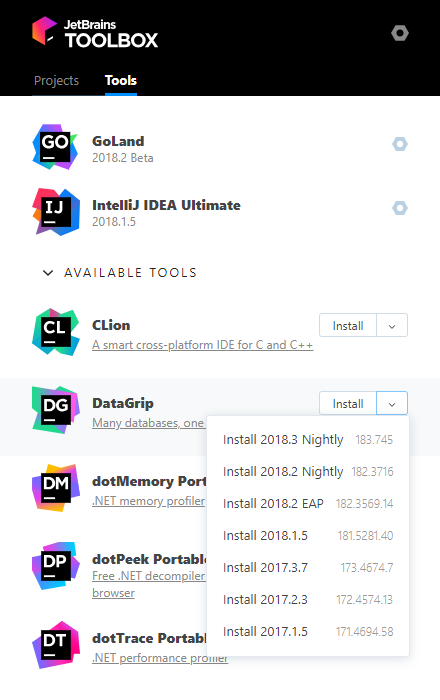
Perform silent installation on Windows
Silent installation is performed without any user interface. It can be used by network administrators to install DataGrip on a number of machines and avoid interrupting other users.
To perform silent install, run the installer with the following switches:
-
/S: Enable silent install -
/D: Specify the path to the installation directory -
/CONFIG: Specify the path to the silent configuration file
For example:
datagrip.exe /S /CONFIG=d:\temp\silent.config /D=d:\IDE\DataGripSilent configuration file
You can download the silent configuration file for DataGrip at https://download.jetbrains.com/datagrip/silent.config
The silent configuration file defines options for installing DataGrip. With default options, silent installation is performed only for the current user (mode=user). If you want to install DataGrip for all users, open the silent configuration file with a text editor, change the value of the installation mode option (mode=admin) and run the installer as an administrator.
Uninstall DataGrip silently
To silently uninstall DataGrip, run the uninstaller with the /S switch as an administrator. The uninstaller is located in the installation directory under bin.
Run cmd (Windows Command Prompt) as administrator, change to the DataGrip installation directory, and run the following:
bin\uninstall.exe /SInstall DataGrip as a snap package on Linux
You can install DataGrip on Linux as a self-contained snap package. Since snaps update automatically, your DataGrip installation will always be up-to-date.
DataGrip is distributed via two channels:
-
The stable channel includes only stable versions. To install the latest stable release of DataGrip, run the following command:
$ sudo snap install datagrip --classic -
The edge channel includes EAP builds. To install the latest EAP build of DataGrip, run the following command:
$ sudo snap install datagrip --classic --edge
When the snap is installed, you can launch it by running the datagrip command.
To list all installed snaps, run sudo snap list. For more information, see the Snapcraft documentation.